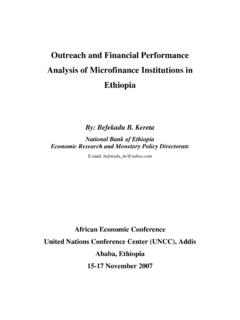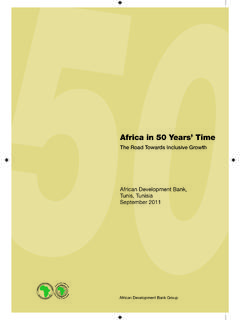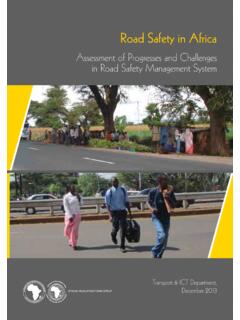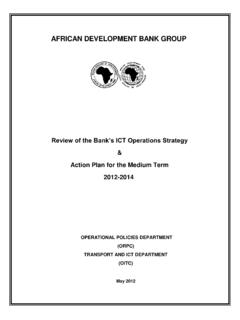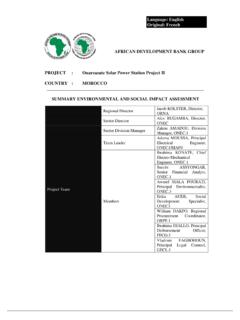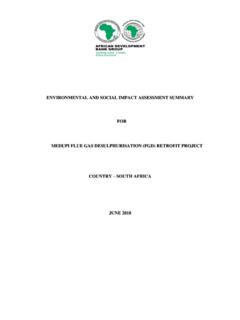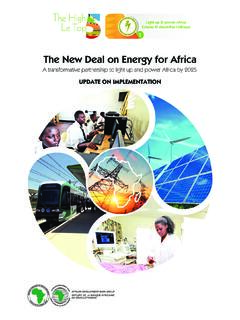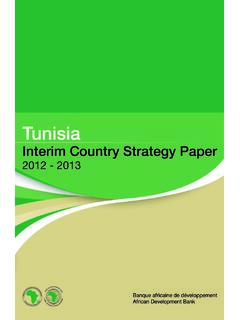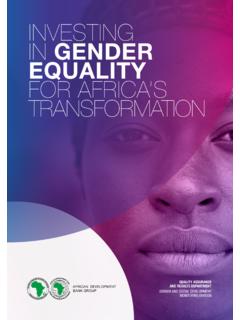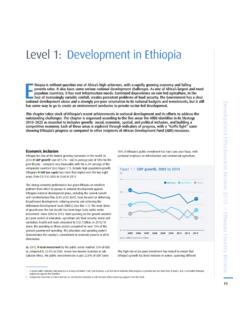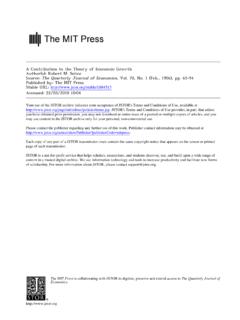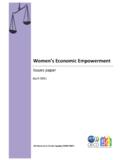Transcription of Income inequality in Africa - African Development Bank
1 1 Income inequality in Africa Introduction Africa has made impressive economic progress in the 2000s. Several countries sustained double-digit growth . Good macro- economic performance provides an opportunity on the one hand, to reduce poverty and on the other hand, to reconcile the differences between revenues by strengthening a strong middle class. However, Africa remains overwhelmed by unequal Income and wealth distribution. The poor performances, in terms of reducing inequality , are not specific to resource-poor countries only, but also a feature of resource-rich countries such as the Congo, Nigeria, Angola and South Africa (AEO, 2011). Africa is experiencing fast economic growth . From 2001-2010, six of the world s ten fastest-growing economies were in Sub-Saharan Africa . Africa has weathered the 2008 financial crisis and its economies are recovering, mainly driven by higher commodity prices and export volumes.
2 The Bank forecasts a GDP growth for 2011 and for 2012, up from in 2010. Yet good economic growth has failed in creating enough job opportunities for the young and inequalities in Income distribution are a real concern both between and within countries (AEO, 2011). The acceleration of per capita growth will not be sufficient to reduce poverty in many African countries. Given Africa s population growth of above 2%, GDP per capita is expected to increase on average by in 2011 and in 2012, after less than 1% in 2009. While the acceleration of per capita growth is commendable, it is not sufficient to significantly reduce poverty. Income per capita growth is too low in many countries, notably in countries that suffer from terms of trade losses due to higher import prices for food and energy. This is currently the case in resource-poor countries, while resource-rich countries benefit from terms of trade gains, so that real Income of resource-rich countries increases faster than real output (ADI 2008/2009, World Bank).
3 The quality and inclusiveness of growth are of increasing concern. In many countries, notably resource-rich countries, Income and wealth are unequally shared, and stronger average Income growth does not necessarily reduce poverty. Africa is the second most inequitable region in the world. In 2010, six out of the 10 most unequal countries worldwide were in Sub-Saharan Africa , particularly Southern Africa . The highest rates of poverty can be observed among young women and youth living in rural areas. Young Africans constitute the majority of the poor. On average 72% of the youth population in Africa lives with less than US$2 per day. The incidence of poverty among young people in Nigeria, ethiopia , Uganda, Zambia and Burundi is over 80% (ADI 2008/2009, World Bank). Income inequalities translate into inequalities in access to basic services and lower opportunities to get out of the poverty trap.
4 The gap between the rich and the poor in education and health remains striking in most African countries. Poor children are more likely to be malnourished, less likely to use health care and less likely to complete five years 2 of primary school. Children under 5 from the poorest quintile are times as likely to be underweight, and times less likely to be immunized against measles than their richer counterparts. In Africa , the number of underweight children has increased from 24 million in 1990 to 30 million in 2010. Stunting causes poor brain Development and as a result stunted children are more likely to learn poorly and do less well in school (ADI 2008/2009, World Bank). It is an opportune time for the Bank to support inclusive growth that can translate in wider participation of the population in the growth process and contribute to reduce Income inequalities.
5 The Arab Spring and growing inequalities in Southern Africa have brought forward the urgent relevance of the inclusive growth agenda which is put forward by the African Development Bank, in particular in its new Human Development Strategy. This strategy shows that Income inequalities need to be tackled through: more inclusive growth which requires increased employment opportunities for all, to support productivity gains and economic growth but also to create a sense of dignity and control over people s own destiny; achieving value for money and accountability in service delivery by fighting corruption and promoting voice in decision making; and more inclusion and social cohesion by promoting safety nets and other risk protection mechanisms. More generally, the AfDB will put this inclusive growth agenda in its Long Term Strategy to draw its RMC s attention on the need to take action to make progress towards a less unequal Income distribution.
6 Poverty levels Africa accounts for a large share of the world s people living in absolute poverty. More than one billion people in the world live on less than US$ 1 a day and billion live on less than US$ 2 per day. Since the late 1980s, the number of people living on less than US$ 1 per day in Sub-Saharan Africa , increased by 70 million to 290 million in 1998, over 46 % of total population and Africa s share of the world s poor rose from just below 20% to close to a quarter (Kayizzi-Mugerwa, 2001). Nowadays, close to 50% of the population in Sub-Saharan Africa lives on less than US$ 1 a day, which constitutes the highest rate of extreme poverty in the world. The number of impoverished people has indeed doubled since 1981. The share of people living on less than US$ 2 a day reaches close to 60% of the population in Liberia and close to 50% in Central African Republic.
7 In North Africa , only of the population lives on less than US$ 1 a day, and 23% on less than US$ 2. Measures of relative poverty also highlight key challenges for the African continent in terms of Income inequalities. The most commonly used measure of inequality is the Gini Coefficient which varies between 0 ( complete equality) and 1 ( complete inequality ). According to the Gini coefficient, Africa is the second most unequal continent after Latin America and inequalities have not been reducing over time (Figure 1). 3 Source: World Development Indicators Inequlities in Income Africa does not provide a unique picture of Income inequalities. The most striking increase in inequality is found in South Africa and the Central African Republic with Gini coefficients rising from 58 to 67 in 6 years (2000-2006) and 43 to 56 in 5 years (2003-2008) respectively.
8 Overall, the Southern part of Africa is the most unequal with Namibia, Comoros, South Africa , Angola, Botswana, Lesotho and Swaziland being in the top ten of the most unequal countries in Africa . However, inequalities have been slightly reducing in Southern Africa over the last decade whereas inequalities have increased in most of the other regions of Africa , although remaining lower than Southern Africa level (Figure 2). This therefore, provides a very worrying picture and shows how crucial the inclusive growth agenda is for Africa . 0102030405060 LACA fricaAsiaNorthAmericaECAE urope52,1 41,1 36,7 22,8 23,9 51,2 45,9 38,7 31,6 30,5 52,2 43,9 37,5 36,7 33,4 32,5 1980-19891990-19992000-2009 Gini Index Figure 1: Africa is the second most unequal continent in the world 4 Figure 2: Southern Africa is the most unequal region in Africa Source: World Development Indicators Inequalities affect more the southern sub-region than the north sub-region countries and more countries in western sub-region than the eastern sub-region.
9 The distribution of the Gini index in Africa indicates that there is a polarization effect as well as concentration. Neighboring countries that hold joint trade patterns have similar inequalities. These inequalities are more concentrated to the south and west compared with the north and east (Figure 3). Figure 3: Geographical distribution of the Gini coefficient in Africa Source: PovCal Data Base and AfDB Estimates. No data for Equatorial Guinea, Libya, Sudan, Somalia and Zimbabwe. 0102030405060 SouthCentralWestEastNorth52,4 28,9 39,3 32,4 40,9 53,3 45,1 44,1 38,4 36,4 48,5 45,0 42,2 41,0 37,4 1980-19891990-19992000-2009 Gini Index 5 Inequalities are also striking when measured by the share of Income that goes to the poorest. In all African countries, the richest capture the largest share of Income , thus exacerbating inequalities between the poor and the rich.
10 This inequality in Income distribution is accompanied by inequalities between rural and urban areas, with the poor being concentrated in rural areas. In Mozambique for instance, the mean share of the lowest 20% of the population is only of total Income while the mean share of the top 20% is about The percentage of rural population that is poor is higher in rural areas ( ) than in urban areas ( ). There are noticeable wide disparities among the rich and poor. The poor account for of Africa 's population and hold of total Income in Africa . In contrast, the rich (only of the population) account for of total Income (Figure 4). These Income disparities are, however, stabilized by the middle class in terms of embodying the concept of equity in Income distribution. For example, the lower-middle class, is almost balanced with of the population living on $4 to $10 per day accounting for of total Income .
